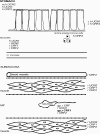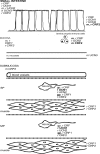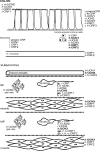Corticotrophin-releasing factor, related peptides, and receptors in the normal and inflamed gastrointestinal tract
- PMID: 21541251
- PMCID: PMC3082851
- DOI: 10.3389/fnins.2011.00054
Corticotrophin-releasing factor, related peptides, and receptors in the normal and inflamed gastrointestinal tract
Abstract
Corticotrophin-releasing factor (CRF) is mainly known for its role in the stress response in the hypothalamic-pituitary-adrenal axis. However, increasing evidence has revealed that CRF receptor signaling has additional peripheral effects. For instance, activation of CRF receptors in the gastrointestinal tract influences intestinal permeability and motility. These receptors, CRF1 and CRF2, do not only bind CRF, but are also activated by urocortins. Most interestingly, CRF-related signaling also assumes an important role in inflammatory bowel diseases in that it influences inflammatory processes, such as cytokine secretion and immune cell activation. These effects are characterized by an often contrasting function of CRF1 and CRF2. We will review the current data on the expression of CRF and related peptides in the different regions of the gastrointestinal tract, both in normal and inflamed conditions. We next discuss the possible functional roles of CRF signaling in inflammation. The available data clearly indicate that CRF signaling significantly influences inflammatory processes although there are important species and inflammation model differences. Although further research is necessary to elucidate this apparently delicately balanced system, it can be concluded that CRF-related peptides and receptors are (certainly) important candidates in the modulation of gastrointestinal inflammation.
Keywords: corticotrophin-releasing factor; gastrointestinal tract; inflammation; urocortin.
Figures



Similar articles
-
Endogenous expression and in vitro study of CRF-related peptides and CRF receptors in the rat gastric antrum.Peptides. 2006 Jun;27(6):1464-75. doi: 10.1016/j.peptides.2005.10.023. Epub 2005 Dec 6. Peptides. 2006. PMID: 16337313
-
Corticotropin releasing factor receptor 1 (CRF1) and CRF2 agonists exert an anti-inflammatory effect during the early phase of inflammation suppressing LPS-induced TNF-alpha release from macrophages via induction of COX-2 and PGE2.J Cell Physiol. 2007 Mar;210(3):774-83. doi: 10.1002/jcp.20900. J Cell Physiol. 2007. PMID: 17117478
-
Involvement of the corticotropin-releasing factor (CRF) type 2 receptor in CRF-induced thyrotropin release by the amphibian pituitary gland.Gen Comp Endocrinol. 2007 Feb;150(3):437-44. doi: 10.1016/j.ygcen.2006.11.002. Epub 2006 Dec 26. Gen Comp Endocrinol. 2007. PMID: 17188689
-
Urocortins and the regulation of gastrointestinal motor function and visceral pain.Peptides. 2004 Oct;25(10):1733-44. doi: 10.1016/j.peptides.2004.05.025. Peptides. 2004. PMID: 15476940 Review.
-
Corticotropin-releasing factor receptor type 1 and type 2 interaction in irritable bowel syndrome.J Gastroenterol. 2015 Aug;50(8):819-30. doi: 10.1007/s00535-015-1086-8. Epub 2015 May 12. J Gastroenterol. 2015. PMID: 25962711 Review.
Cited by
-
Chronic Stress, Inflammation, and Colon Cancer: A CRH System-Driven Molecular Crosstalk.J Clin Med. 2019 Oct 12;8(10):1669. doi: 10.3390/jcm8101669. J Clin Med. 2019. PMID: 31614860 Free PMC article. Review.
-
Vagal neurocircuitry and its influence on gastric motility.Nat Rev Gastroenterol Hepatol. 2016 Jul;13(7):389-401. doi: 10.1038/nrgastro.2016.76. Epub 2016 May 25. Nat Rev Gastroenterol Hepatol. 2016. PMID: 27251213 Free PMC article. Review.
-
Stress and corticotropin releasing factor (CRF) promote necrotizing enterocolitis in a formula-fed neonatal rat model.PLoS One. 2021 Jun 10;16(6):e0246412. doi: 10.1371/journal.pone.0246412. eCollection 2021. PLoS One. 2021. PMID: 34111125 Free PMC article.
-
Urinary bladder hypersensitivity and dysfunction in female mice following early life and adult stress.Brain Res. 2016 May 15;1639:58-73. doi: 10.1016/j.brainres.2016.02.039. Epub 2016 Mar 2. Brain Res. 2016. PMID: 26940840 Free PMC article.
-
Plasticity in the brainstem vagal circuits controlling gastric motor function triggered by corticotropin releasing factor.J Physiol. 2014 Oct 15;592(20):4591-605. doi: 10.1113/jphysiol.2014.278192. Epub 2014 Aug 15. J Physiol. 2014. PMID: 25128570 Free PMC article.
References
-
- Ardati A., Goetschy V., Gottowick J., Henriot S., Valdenaire O., Deuschle U., Kilpatrick G. J. (1999). Human CRF2 alpha and beta splice variants: pharmacological characterization using radioligand binding and a luciferase gene expression assay. Neuropharmacology 38, 441–44810.1016/S0028-3908(98)00201-9 - DOI - PubMed
LinkOut - more resources
Full Text Sources

